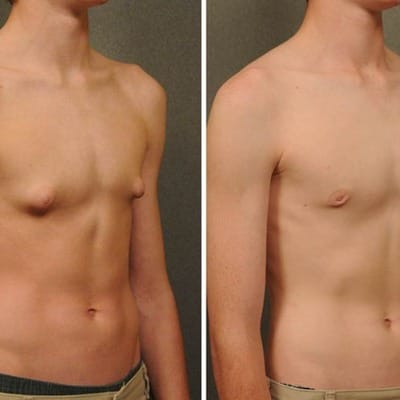Boys and men who have gynecomastia have abnormalities in the growth of their breast tissue, usually due to chemical issues. They could face gynecomastia during puberty when the body goes through significant chemical changes. Even if it’s a temporary problem for many, it may nonetheless cause pain and self-consciousness. In this blog, we will discuss the reasons and treatment of gynecomastia if you’re thinking about how to get rid of it throughout your youth.
What is Gynecomastia During Puberty?
It is caused by an imbalance of testosterone the male sexual hormone and estrogen, the female sex hormone, during puberty. During major hormonal changes that occur during puberty, the male may experience an increase in the breast tissue.
However, in most instances, gynecomastia can lead to pain in the chest, as well as swelling. For teens, this ailment usually resolves spontaneously within six months to two years. However, there is something that you may take to treat the gynecomastia if you are trying to minimize the effects.
Possible Causes of Gynecomastia in Puberty.
Some conditions must be met for this condition which causes a boy to develop gynecomastia during puberty.
Hormonal Imbalance: The variation that occurs due to hormonal change when a boy develops into a man is the main cause of gynecomastia.
Drugs: These include antibiotics and medicines that serve to treat gastritis; such medicines may lead to hormonal changes and gynecomastia.
Obesity: Another condition is that obesity causes the fat deposits around the chest area to rise, thereby getting to the point of gynecomastia quickly.
Underlying Medical Conditions: At times, the anemic situation, which leads to gynecomastia, might be related to liver ailment or thyroid abnormalities.
What Are Non-Surgical Ways to Manage Gynecomastia?
Wait It Out:
It is common to have gynecomastia in young men and it usually becomes less apparent once hormonal balance is corrected. Waiting is important since the situation tends to resolve itself without any medical intervention.
Pay Attention to Your Diet
Consume a well-rounded diet: To prevent the accumulation of fats consume foods that can help you achieve your target weight of maintain a fit body, these include; fruits, vegetables, whole grain meals, and lean foods.
Eat less prepared food: Avoid fatty and sweet foods because these could develop chemical issues and lead to the addition of pounds.
Eat Foods That Raise Testosterone: The foods that increase great testosterone levels include fish, especially salmon, eggs, and nuts.
Engage in Regular Exercise
Gynecomastia may be lessened by exercise, especially if it is linked to fat. Pay attention to tasks that build muscle and burn fat:
Cardio Workouts: Exercises like swimming, biking, and running may help lower chest fat as well as overall body fat.
Strength training: By strengthening the chest muscles, activities like push-ups and bench pulls may improve the look of the chest area.
Rest and Hydrate
For gut health, drinking enough water and getting enough sleep are important. To help your body’s natural repair processes, try to get at least 7 to 9 hours of sleep each night.
Avoid triggers
Avoid Steroids: Anabolic drugs have the potential to cause gynecomastia and upset hormone levels.
Limit your use of drugs: Hormonal balance and liver function may be affected by these toxins.
Medical Treatment Options
Consult with an aesthetician if changing lifestyle doesn’t fix the problem or if gynecomastia causes major pain or mental suffering. They could suggest the following:
Surgery (in Rare Cases): Teenagers seldom need surgery; it is generally the last choice. However, treatments like liposuction or surgery may remove more fat from people with chronic gynecomastia that doesn’t go away with time.
Medications: Of course, in some cases, gynecomastia can be treated using medicines like raloxifene or Nolvadex. These drugs help manage hormone levels and breast tissue development since hormone receptors stimulate the growth of breast tissue.
Hormone treatment: To restore the balance between testosterone and estrogen, a surgeon may recommend hormone therapy if there is a major hormonal imbalance.
Managing the Effects on Emotions
Gynecomastia may have a major psychological effect, especially on young people whose body image and sense of self are still forming. The following are some ways to address the psychological effects:
- Wearing bigger clothes may help lower feelings of self-consciousness.
- Discuss your views with a counselor, family member, or close friend.
- Take part in hobbies or sports that boost self-esteem and help you separate from physical fears.
When to Consult a Physician
Even though gynecomastia during puberty is generally temporary, there are a few signs that might suggest you need to see a doctor:
- Soreness or pain in the chest area
- Breast tissue grows quickly.
- Symptoms of an underlying sickness, such as tiredness or fast weight loss
If the issue continues after two years or if you see any danger signs, see a physician.
Final Thoughts:
During puberty, gynecomastia in Islamabad is a common and usually temporary problem brought on by hormonal changes. The best treatment is usually to wait things out, although avoiding triggers, moving, and keeping a healthy diet may help lessen symptoms. There are also medication choices available if the problem continues or causes pain. So, visit Enfield Royal Clinics and consult with our best Plastic Surgeon Dr Husnain Khan to discuss how to get rid of Gynecomastia during Puberty. Most teens can beat gynecomastia and have confident, healthy lives with enough time, patience, and care.










Leave a Reply